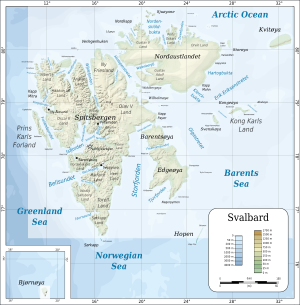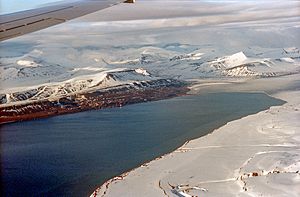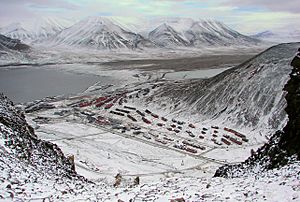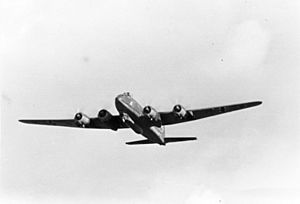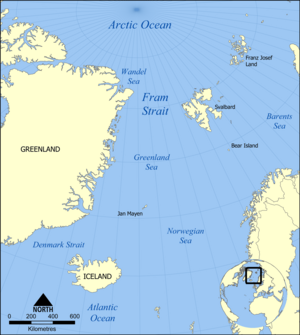Operation Gearbox facts for kids
Quick facts for kids Operation Gearbox |
|||||||
|---|---|---|---|---|---|---|---|
| Part of the Arctic Campaign of the Second World War | |||||||
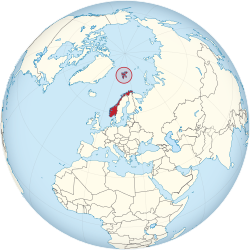 Global view of Norway (Svalbard circled) |
|||||||
|
|||||||
| Belligerents | |||||||
| Commanders and leaders | |||||||
| Ernst Ullring (Norwegian Military Governor) |
Dr Erich Etienne (killed 23 July 1942) | ||||||
| Strength | |||||||
| 57 men | 18 men | ||||||
| Casualties and losses | |||||||
| 4 killed (23 July 1942) | |||||||
Operation Gearbox was a secret mission during World War II. It took place from June to September 1942. This operation was a joint effort between Norway and Britain. Their goal was to take control of the Arctic island of Spitsbergen. Spitsbergen is the main island of the Svalbard Archipelago.
This mission followed an earlier attempt called Operation Fritham in May. Fritham failed when German planes attacked. The goal was to protect the important coal mines on Spitsbergen. Norwegian soldiers, along with supplies, arrived by a British ship on July 2.
The survivors from the earlier mission, Fritham, had saved some gear. They set up camp in Barentsburg. This town had been empty since 1941. They sent out teams to explore. The British Navy already knew a lot about what had happened. They got secret information from German radio messages.
The new soldiers made Barentsburg safer. They also sent teams to attack a German weather station. This station was in Longyearbyen. But the Germans had left three days before. The Norwegian forces blocked the German airstrip. On July 23, a German plane was shot down. It was flying low over the landing area.
Operation Gearbox was a success. Norway showed it still controlled the island. No Norwegian or British soldiers were hurt. The Germans could not send another weather team. This operation also prepared the way for Operation Gearbox II.
Contents
Background to the Operation
Svalbard's Importance
The Svalbard Archipelago is in the Arctic Ocean. It is about 650 miles from the North Pole. The islands have mountains with snow all year. Some areas have glaciers. There are also flat areas near rivers and coasts. In winter, the islands are covered in snow. The bays freeze over.
Spitsbergen Island has many large fjords on its west coast. Isfjorden is up to 10 miles wide. The Gulf Stream warms the waters. This keeps the sea free of ice in summer. Towns like Longyearbyen and Barentsburg were built in inlets.
People from different countries settled here. A treaty in 1920 made the islands neutral. It also recognized mining and fishing rights. Before 1939, about 3,000 people lived there. Most were Norwegian and Russian. They worked in coal mining. Coal was dug from mines. It was then moved to the shore by cables or rails. Ships collected the coal after the summer ice melted. By 1939, about 500,000 tons of coal were produced each year. This was shared between Norway and Russia.
Secret Intelligence
The British had a secret code-breaking center. It was called Bletchley Park. By June 1941, they could read German naval codes. These codes were used by ships and U-boats. In February 1942, the codes for U-boats in the Atlantic changed. But German ships in the Arctic still used the old codes.
By mid-1941, British listening stations could read German air force radio messages. This gave early warnings of German flights. British ships also had special teams. These teams could read German air force signals at sea. They could often predict attacks before radar detected them.
The Germans also had their own code-breaking service. It was called the B-Dienst. In February 1942, they broke a British naval code. They could read it until January 1943.
The Germans did not attack Svalbard when they invaded Norway in 1940. Life on the islands stayed mostly the same. Wireless stations kept sending weather reports. In July 1940, a German cruiser searched the area. It was looking for British ships. But it only found a Finnish cargo ship.
In July 1941, Britain decided to send ships to the Arctic. They would work with the Soviet Union. A British admiral, John Tovey, disagreed. He wanted to operate further south. There were more targets and better air cover there.
British admirals flew to a Soviet port. One admiral set up a British military base in Moscow. He reported that the port was too close to German territory. Its air defenses were also weak. Another admiral was sent to check Spitsbergen. He wanted to see if it could be a naval base. But he decided its advantages were not as great as thought.
Operation Gauntlet
As the first Arctic convoy gathered, a British force sailed for Svalbard. This was Operation Gauntlet. The plan was to evacuate Norwegian and Russian civilians. They would also destroy the coal industry. Two cruisers, five destroyers, an oil ship, and a troop transport were used. The transport carried 645 soldiers.
The expedition landed at Barentsburg. They destroyed the coal mines. They also evacuated about 2,000 Russians. These people were taken to Archangelsk. The Norwegian military governor kept the wireless station working. This made it seem like business was normal. They also captured several ships.
The Canadian soldiers left on September 2. The force sailed home the next day. They took 800 Norwegian civilians and the captured ships. Two cruisers went towards the Norwegian coast. They were looking for German ships. On September 7, they found a German convoy. They sank a German training ship. But two troop transports escaped. One British ship was damaged. The naval force reached Scapa Flow on September 10.
German Weather Stations, 1941–1942
After Operation Gauntlet, Britain thought Germany would occupy Svalbard. They believed Germany would use it as a base. But Germany was more interested in weather data. The Arctic is where much of Western Europe's weather comes from. By August 1941, the Allies had removed German weather stations. These were on Greenland, Jan Mayen, and Bear Island. Civilian weather reports from Spitsbergen also stopped.
Germany used U-boats and planes for weather reports. But these were easy to attack. So, the German Navy and Air Force looked for land sites. These sites would have manned or automatic weather stations. A German air unit, Wekusta 5, was based in northern Norway. Their planes flew over the Arctic Ocean. They gained experience in setting up and supplying weather stations.
The wireless on Spitsbergen stopped working in September. German planes saw the damage the Canadians had done. They also saw one man waving. Dr. Erich Etienne, a polar explorer, led a mission. He wanted to set up a manned station. But winter was coming. Advent Bay was chosen for its wide valley. This made it easier for planes to land. The ground was also good for an airstrip. The nearby town of Longyearbyen was also a plus.
An airstrip was marked out. It was about 1,800 by 250 yards. It was firm when dry and hard when frozen. But it could get muddy after rain. The Germans used a hut as a control room. They called the site Bansö. Flights of men and supplies began on September 25. Pilots learned to land on rough ground.
The British knew what was happening through their secret code-breaking. This was easy because the Germans used radio a lot. Four British ships were sent to investigate. They reached Isfjorden on October 19. A German plane spotted the ships. The 30 men at Bansö were quickly flown to safety. Bansö was empty when the British arrived. But they found some code books. When the British left, the Germans returned.
After 38 supply flights, Dr. Albrecht Moll and three men arrived. They spent the winter sending weather reports. On October 29, 1941, another German weather team was set up. They were in Lilliehöökfjorden. Landing planes was riskier in winter. Soft snow could stop planes. It could also hide holes.
The Moll team at Bansö called for planes when the weather was good. Pilots would check the landing ground before landing. On May 2, 1942, parts for an automatic weather station arrived. It was called Krote (toad). It would be flown to Bansö. The Moll team would then be brought back. On May 12, a good weather report came. A German plane was sent with supplies. It also carried technicians to install the Krote. The plane landed carefully. But its wheels got stuck in the snow. The ten crew and passengers joined the ground team. They had been alone for six months.
Operation Fritham's Challenges
On April 30, 1942, two Norwegian ships sailed from Scotland. They carried 60 Norwegian soldiers. They also had three British officers. Each ship had a 20 mm anti-aircraft gun. But no one knew how to use them. The ships reached Svalbard on May 13. They entered Isfjorden.
Grønfjorden was covered in thick ice. The ice breaking was delayed. Scouting teams found no one in Barentsburg. A German plane flew over Isfjorden. The Norwegian leader wanted to unload quickly at Barentsburg.
At 8:30 p.m., four German Fw 200 Condor bombers appeared. The valley sides were so high that the bombers arrived without warning. The third bomber hit one Norwegian ship. It sank right away. The other ship caught fire. Thirteen men were killed. Nine men were wounded. All the equipment was lost.
Barentsburg was close by. The survivors found plenty of food. It was a Svalbard custom to store food for winter. They also found an infirmary with medical supplies. German bombers returned on May 15. But the survivors hid in mine shafts. The fit men cared for the wounded. They stayed hidden when German planes were around. Teams were sent to explore other areas. They also checked on the Germans at Advent Bay.
Getting Ready for Gearbox
The Plan
After a convoy operation in May 1942, a British air marshal suggested a flying-boat base. It would be on Spitsbergen. But the British Navy said no. Svalbard was too far away. Bad weather would often ground planes. Also, Operation Fritham had faced many problems.
The air marshal also suggested basing flying boats in north Russia. Eight Catalina planes were sent there. They would help with the next convoy. He also wanted to send torpedo-bombers. But the Navy refused due to lack of planes.
At the end of June, a report was given to the Navy. It described the disaster of May 14. It also talked about the German strength at Bansö. The report suggested sending more soldiers to achieve Fritham's goals. The Navy decided to continue. Fritham was ended and replaced by Operation Gearbox.
To avoid another disaster, Norwegian forces would lead the mission. But the Navy would deliver supplies. These trips would happen at the same time as convoys. A British cruiser and a destroyer would start Gearbox. They would carry 57 Norwegian soldiers and supplies to Spitsbergen.
Catalina Reconnaissance Flights
The British Navy sent a pilot and officer to brief a commander. They were asked to photograph the Spitsbergen coast. This would help the ship's crew. The pilot and officer described the pier at Barentsburg. They also mentioned ice floes. The pilot agreed to take more photos of the pier.
A Catalina flying boat took off on June 25. It headed for Iceland for ice checks. The crew then flew towards Greenland. They saw ice through the fog. The Catalina flew into Scoresby Sound. The crew photographed 200 miles north. They then turned back for Iceland.
The ice and weather reports were sent. The Catalina took off again on June 26. It flew to Jan Mayen, then to Spitsbergen. The crew flew low to take photos. They then turned east to check other areas. They found Sveagruva seemed empty. The crew took pictures of the coast. They also photographed Green Harbour and Barentsburg. They contacted the Fritham Force. They then photographed the pier.
The pilot landed the Catalina. He dropped off the officer and another person. He then took off for Advent Bay. He wanted to check on the Germans. There was no snow near Longyearbyen. But tracks were seen near the airstrip. They followed the tracks to a plane near a hut. There were piles of equipment and a truck. The Catalina gunners fired at what was a German Ju 88 plane. They fired 1,500 rounds. Smoke came from the Ju 88's tail. The Catalina crew dropped a message to the ground team. They then flew back towards Scotland.
German Air Force Activity
The German team at Bansö reported the British flight. On June 12, they said the landing ground was dry enough. A German Ju 88 plane landed. But it damaged its propellers while moving. This stranded the crew. It increased the German party to 18 men. German planes flew to Spitsbergen daily. But the crews were warned off.
The Germans thought about using floatplanes. But the east end of Isfjorden was too full of ice. The idea was dropped. In the midnight sun, the ice in the west cleared faster. This was near the Allied positions. The Germans reported the Catalina attack on June 27. The Ju 88 was a total loss. They claimed to have damaged the British plane.
On June 30, the German party sent a message. They said the airstrip was dry enough for Ju 52 planes. Supply flights started again. A Norwegian team watched the planes. This team had tried to destroy the German headquarters. On clear days, German pilots flew over the mountains. When visibility was poor, they took the coast route. This route passed Barentsburg.
Operation Gearbox in Action
First Days: June 28 – July 5
The British ships Manchester and Eclipse left for Spitsbergen. They carried the Norwegian soldiers. The ships arrived in Iceland on June 28. They met the Catalina pilot and navigator. They were briefed on the special reconnaissance flight. The cruiser waited until June 30 to leave. This was to make it seem like part of a larger convoy.
The ships sailed north. They then turned east to approach Isfjorden from the west. Eclipse was refueled on July 1. This happened during a thick fog. On July 2, the crews saw the fjord clearly.
Off Barentsburg, the ships received a welcome signal. The Fritham Force reported German planes flew daily. But no German sea or ground forces had appeared. In bad weather, German planes followed the coast. This had led to the discovery of the earlier Norwegian ships. The pier was too muddy for docking. The ships kept their engines running. Crews stayed at anti-aircraft stations.
Many small boats made 121 trips. They unloaded the Norwegians and supplies. These supplies included wireless radios and anti-aircraft guns. Skis, sledges, and other Arctic gear were also unloaded. Some men from the Fritham party were taken aboard. By 7:00 p.m., the ships had left. The men ashore quickly hid all signs of the visit.
Unlike the previous leader, the new Norwegian commander had a different order. He was to reclaim Norwegian control over Svalbard. He found a bombed town. Frozen animals were scattered around. Smoke rose from burning coal piles. The new soldiers were dismayed. Their machine-guns had no ammunition belts. Only the 20 mm guns and some other machine-guns were left.
On July 3, a plane was heard flying along Isfjorden. It was thought to have landed at Longyearbyen. Later, a Ju 52 plane was seen. By July 5, four anti-aircraft guns were set up. The gun crews practiced.
Mid-July: July 6–14
On July 12, a supply flight was planned. It would deliver the missing ammunition belts to Barentsburg. After that, the plane would search for survivors of a lost convoy. The Catalina would fly east of Sørkapp. It would then fly along the Polar ice. Then it would turn south to north Russia.
After resting, the crew would fly back to the Polar ice. They would then fly east again. Then they would return to Russia. Catalina N-November left on July 13. It reached Barentsburg on July 14. But it was hit by machine-gun fire by mistake. The Catalina landed for ten minutes. It unloaded supplies. Then it flew on to Hopen.
Late July: July 15–29
Once the gun parts were delivered, the Norwegian commander acted. He mounted a gun on a boat. On July 15, he set off with ten men. They would attack the Germans at Longyearbyen. But the last Germans on Spitsbergen had already flown back to Norway. This was on July 9.
The Germans were gone. But the Ju 88 plane shot on July 1 was still there. The wireless and other equipment were working. Supplies were plentiful. The buildings were in good condition. This suggested the Germans might return. The automatic weather station was found. It was taken back to Barentsburg. It would be sent to Britain. A team was left to guard the airstrip.
A German Ju 88 was sent from Norway on July 20. It was to check why the weather station stopped. The crew saw the base was destroyed. They came under machine-gun fire from the Norwegians. The Norwegian team at Sveagruva heard the bomber. They assumed the German base was alerted.
On July 21, a Ju 88 flew over Green Harbour. It was fired on by Norwegian gunners. The plane's engine smoked. A hole appeared in a wing. German records showed the landing ground was too muddy in summer. As a precaution, the Norwegians removed ground markers. They dug trenches and placed obstacles on the strip.
Another transmitter and supplies were found. The Norwegian commander sailed south. He delivered weapons to the Fritham Force team. He also took nine men to strengthen Barentsburg. In Norway, Dr. Erich Etienne arranged a flight to Spitsbergen. A Ju 88 flew over Advent Bay on July 23. It was to check the Allied interference. As the plane flew low, a Norwegian gunner fired. The bomber crashed and exploded. Two rounds had hit an engine. The area had coal cables. The Ju 88 might have hit one. The crew were buried. Code books were saved from the wreckage.
August Events
The loss of the German crew led to more flights. But the Germans could only see the airstrip was occupied. They lacked the forces to take it back. The Norwegians had gained secret information. They had no more casualties. Wireless operators sent much information to Britain. On July 29, a Catalina plane brought medical supplies. It returned with an officer on July 30. They discussed the next operation, Gearbox II.
The officer was happy that the Norwegians controlled Isfjorden. It could be used as a seaplane base. In early August, the Norwegian commander took a team north. They searched for another German weather station. But they only found a footprint. On August 20, a German U-boat entered Isfjorden. It fired its deck gun at shore buildings. At Barentsburg, the Norwegians fired back. They used a machine-gun on a boat. They also used an anti-aircraft gun. This forced the U-boat to fire from further away. The Norwegians had no casualties again.
Aftermath
Operation Gearbox II
After a difficult convoy, a torpedo-bomber plan was approved. This was Operation Orator. During another convoy, PQ 18, supply ships sailed for Spitsbergen. They anchored in Van Mijenfjorden. They were an advanced refueling party. From September 9 to 13, destroyers refueled there.
Operation Gearbox II began with another supply run. A British cruiser and destroyer arrived on September 17. They brought 130 tons of supplies. They also brought more Norwegian troops. Another British ship arrived the next day. It brought 110 tons of stores.
The ships kept their engines running. Crews were ready for anti-aircraft action. The ships unloaded and left in six hours. Two Husky dog teams with forty dogs were delivered. Three Bofors guns, two tractors, boats, and wireless gear also arrived. Winter supplies were also delivered.
A pilot named Healy took part in Operation Orator. He left Russia on September 25. He was returning to Scotland via Svalbard. He was to pick up an officer. Bad weather forced a return to Murmansk. Healy was killed in a fight with a German plane. On October 19, another British ship delivered supplies. A Norwegian vessel made a trip in November. On June 7, 1943, more British ships sailed from Iceland. They landed men and supplies at Spitsbergen on July 10.


